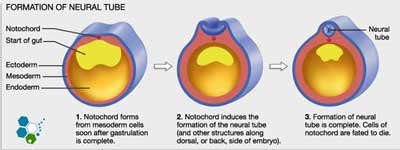
An Ectoderm is a body of cells forming the outermost layer of major organ systems in the body, such as the skin, neural cells and nervous system, and the sensory organs. This layer is formed by the blastocyst’s inner cell mass.[1]
The cells of various germ layers can differentiate themselves [2] through lab culturing to try to regenerate and repair diseased organs and dysfunctioning systems in the body through a process known as organogenesis.
The ectoderm layer can also give rise to a person’s:
During embryonic development, the embryo undergoes gastrulation, forming three primary germ layers: ectoderm, mesoderm, and endoderm. These germ layers give rise to various tissues and organs in the developing organism.
The ectoderm is the outermost germ layer. It differentiates to form a wide variety of tissues and structures, including:
The endoderm is the innermost germ layer and differentiates to form the lining of many internal structures, as well as certain glands:
Understanding the derivatives of the germ layers is fundamental in developmental biology. It helps scientists and medical professionals predict and understand congenital anomalies and the embryonic origin of various tissues and organs.
[1] ^ Pieper, Mareike, Katja Ahrens, Elke Rink, Annette Peter, and Gerhard Schlosser. 2012. Differential distribution of competence for panplacodal and neural crest induction to non-neural and neural ectoderm. Development (Cambridge, England), no. 6 (February 8). doi:10.1242/dev.074468. https://www.ncbi.nlm.nih.gov/pubmed/22318231
[2] ^ Yardley, Nathan, and Martín I García-Castro. 2012. FGF signaling transforms non-neural ectoderm into neural crest. Developmental biology, no. 2 (September 19). doi:10.1016/j.ydbio.2012.09.006. https://www.ncbi.nlm.nih.gov/pubmed/23000357
Zombie cells, also called senescent cells, are non-dividing cells that accumulate in the body due to stress or damage, resisting… Read More
Chimeric antigen receptor-T cell treatment (CAR-T cell therapy) holds immense potential to revolutionize organ transplantation, particularly for patients who struggle… Read More
In the ever-evolving landscape of nutrition science, the discourse around dietary fats has undergone significant transformation. The Regeneration Center is… Read More
New research shows that specific types of brain cells become active after brain injuries and exhibit properties similar to those… Read More
Chemokines, critical components in the immune system, are small proteins that facilitate the migration and positioning of immune cells throughout… Read More
Stem cell research examines everything from gene expression to differentiation capacities to therapeutic potentials. With such diverse data types and… Read More